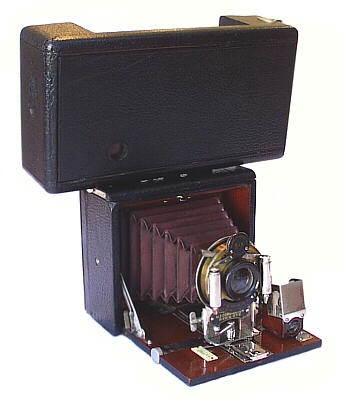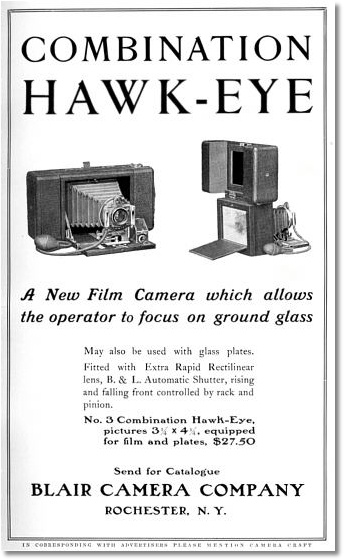|
|




No.3 Combination Hawk-Eye shown with the
rollfilm holder in the upright position for plate use.
rollfilm holder in the upright position for plate use.
The Blair No.3 Combination Hawk-Eye is a scarce folding-bellows camera that was successor to
the earlier Blair Focusing Weno Hawk-Eye (c1902). The Combination Hawk-Eye is similar to the
better known No.4 Screen Focus Kodak in which the rollfilm back hinges up for composing and
focusing an image on a ground glass carrier. In addition, the rollfilm back could be completely
removed and the camera used exclusively with glass plates. The No.3 is the smallest of the
combination cameras using 118 film for 3-1/4 x 4-1/4" exposures.
Combination cameras are extremely awkward to use and visually quite strange - especially when set up to use the ground glass as a composing and critical focusing aid. These cameras may have been design experiments reacting to the shift in popularity from dry-plates to rollfilm systems in the 1890s. The likely benefit was that a photographer could buy one camera for both worlds. Owing to the scarcity of combination cameras, the important amateur photographer market must not have embraced the "one-camera / both worlds" concept.
Several manufacturers offered cameras that could use both rollfilm and dry-plates before Blair introduced their smaller combination cameras. Examples include the 1893 No.4 Folding Kodak (Improved version), the Blair Hawk-Eye Detective Camera (with accessory rollfilm carrier), and rollfilm cameras such as the No.4 Cartridge Kodak (with accessory dry-plate back). So what makes the Blair Focusing Weno Hawk-Eye and Combination Hawk-Eye historically interesting?
Combination cameras are extremely awkward to use and visually quite strange - especially when set up to use the ground glass as a composing and critical focusing aid. These cameras may have been design experiments reacting to the shift in popularity from dry-plates to rollfilm systems in the 1890s. The likely benefit was that a photographer could buy one camera for both worlds. Owing to the scarcity of combination cameras, the important amateur photographer market must not have embraced the "one-camera / both worlds" concept.
Several manufacturers offered cameras that could use both rollfilm and dry-plates before Blair introduced their smaller combination cameras. Examples include the 1893 No.4 Folding Kodak (Improved version), the Blair Hawk-Eye Detective Camera (with accessory rollfilm carrier), and rollfilm cameras such as the No.4 Cartridge Kodak (with accessory dry-plate back). So what makes the Blair Focusing Weno Hawk-Eye and Combination Hawk-Eye historically interesting?
Blair combination cameras were the first self-casing, folding-bellows outfits that did not require the rollfilm back to be removed. Although primarily
rollfilm cameras, they could convert to dry-plates midway through a roll of film or use the ground glass as a rollfilm focusing aid without having to
swap backs (or external rollfilm carriers).
No.3 Combination Hawk-Eye, c.1904
Blair Camera Company, NY.
Blair Camera Company, NY.
Multi-Lens Cameras | View Cameras | Self-Casing Cameras | Solid Body Cameras | References & Advertisements
Home | What's New | Show Schedule | Wanted | For Sale | Links | Site Map | Email
Home | What's New | Show Schedule | Wanted | For Sale | Links | Site Map | Email
Copyright ©2001 by Rob Niederman - ALL RIGHTS RESERVED
Return to the Self-Casing Cameras page
The conversion process was convenient because the rollfilm back stayed attached to the
camera. However the No.4 Screen Focus Kodak had a slightly better design, allowing its
ground glass carrier and dark slide to be stored inside the rollfilm back when not in use.
The advertisement shown here illustrates two views of the Combination Hawk-Eye: opened and closed. The tab shown on top of the camera at left is the darkslide which would be removed when taking a picture.
When the back is rotated upward, a ground glass back must be attached to the camera. What is not shown or described in the advertisement, is the fact that the ground glass assembly must first be removed from the camera body before closing the rollfilm back. Unlike the No.4 Screen Focus Kodak which can store the ground glass assembly inside the back, the Blair has no storage for the ground glass or darkslide.
At $27.50 (or about $521 in year 2000 currency), the newly introduced Combination Hawk-Eye was advertised for a substantially lower price than the $87.50 No.4 Screen Focus Kodak.
The advertisement shown here illustrates two views of the Combination Hawk-Eye: opened and closed. The tab shown on top of the camera at left is the darkslide which would be removed when taking a picture.
When the back is rotated upward, a ground glass back must be attached to the camera. What is not shown or described in the advertisement, is the fact that the ground glass assembly must first be removed from the camera body before closing the rollfilm back. Unlike the No.4 Screen Focus Kodak which can store the ground glass assembly inside the back, the Blair has no storage for the ground glass or darkslide.
At $27.50 (or about $521 in year 2000 currency), the newly introduced Combination Hawk-Eye was advertised for a substantially lower price than the $87.50 No.4 Screen Focus Kodak.
Source: Camera Craft Magazine, June 1904